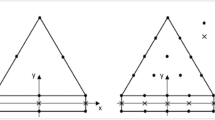Abstract
Soil nailing is increasingly adopted in potentially unstable slopes and steep excavations in Concepción, Chile. The paper presents a study of soil nailing design and construction in Maicillo, a heavily weathered granite. The stability of the soil nailed wall was analysed using a limit equilibrium block method. The lowest factor of safety was obtained when the nailed wall was 8 m high but without the bottom row of nails. This was followed by the global seismic case using an acceleration factor k h = 0.15. The occurrence of a strong earthquake (magnitude 8.8) 2 weeks after completion of the projected allowed a re-assessment of the soil nailing design. Despite registering a maximum acceleration of 0.63 g near the project site, the nailed wall did not present any damage, probably due to the use of undrained shear strength parameters.
Résumé
Le clouage des sols est une technique de plus en plus adoptée pour les pentes potentiellement instables et les excavations à pentes raides à Concepción, au Chili. L’article présente une étude de dimensionnement et mise en œuvre d’un clouage de sol dans une zone de granite très altéré, nommé Maicillo. La stabilité de la paroi de sol cloué a été analysée en utilisant une méthode d’équilibre limite. Le plus faible coefficient de sécurité a été obtenu lorsque la paroi clouée faisait 8 m de hauteur, mais sans la rangée inférieure de clous. Cette situation était suivie par le cas sous sollicitation sismique avec un facteur sismique k h = 0,15. Un séisme de forte magnitude (M = 8,8) deux semaines après la réalisation de l’ouvrage a permis de réévaluer le dimensionnement de la paroi clouée. En dépit de l’enregistrement d’une accélération maximale de 0,63 g à proximité du site de projet, la paroi clouée ne présentait aucun dommage, probablement en raison de l’utilisation de paramètres de résistance au cisaillement non drainé.










Similar content being viewed by others
References
Barrientos S (2010) Terremoto Cauquenes 27 febrero 2010. Updated technical report, Seismological Service, Universidad de Chile. http://ssn.dgf.uchile.cl/informes/INFORME_TECNICO.pdf (in Spanish)
Boroschek R, Soto P, León R (2010) Maule region earthquake, February 27, 2010, Mw = 8.8. Renadic report 10/08, rev. 2, Universidad de Chile. http://www.renadic.cl/red_archivos/RENAMAULE2010IR2.pdf
Bustamante M, Doix B (1985) Une méthode pour le calcul des tirants et micropieux injectées. Bulletin des Liaison des Laboratoires des Ponts et Chaussées, no. 140
Gaessler G (2007) Exact solution and practical approach to the most unsafe failure mechanism of nailed walls in the load case earthquake. In: Proceedings of the ECSMGE, Madrid, vol 2, pp 517–521
Gaessler G, Gudehus G (1981) Soil nailing—some aspects of a new technique. In: Proceedings of the 10th international conference on soil mechanics and foundation engineering, Stockholm, vol 3, pp 665–670
GGU-Stability (2008) Slope stability analysis and analysis of soil nailing and reinforced earth walls. Civilserve GmbH, Steinfeld
Guilloux A, Notte G, Gonin H (1983) Experiences on a retaining structure by nailing in moraine soils. In: Proceedings of the eighth European conference on soil mechanics and foundation engineering, improvement of ground, Helsinki, vol 2, pp 499–502
Hanna S, Juran I (2000) Performance of soil reinforcement systems in earthquake zones. J Geotech Geoenviron Eng ASCE 123(10):1155–1169
Poblete M, Dobry R (1968) Modelo dinámico del suelo de Concepción. Revista IDIEM 7(6):12–18 (in Spanish)
Ruíz C (2002) Determinación de los parámetros CIU en muestras inalteradas de Maicillos graníticos residuales de Concepción. Civil Eng degree project, University of Concepción (in Spanish)
Stocker MF, Korber GW, Gaessler G, Gudehus G (1979) Soil nailing. In: Proceedings of the International Conference on Soil Reinforcement, Paris, pp 469–474
Tufenkjian MR, Vucetic M (2000) Dynamic failure mechanism of soil-nailed excavation models in centrifuge. J Geotech Geoenviron Eng 126(3):227–235
Verdugo R, Villalobos F, Yasuda S, Konagai K, Sugano T, Okamura M, Tobita T, Torres A (2010) Description and analysis of geotechnical aspects associated to the large 2010 Chile earthquake. Obras y Proyectos 8:25–36
Yin JH, Su LJ, Cheung RWM, Shiu YK, Tang C (2009) The influence of grouting pressure on the pullout resistance of soil nails in compacted completely decomposed granite fill. Géotechnique 59(2):103–113
Author information
Authors and Affiliations
Corresponding author
Rights and permissions
About this article
Cite this article
Villalobos, S.A., Oróstegui, P.L. & Villalobos, F.A. Re-assessing a soil nailing design in heavily weathered granite after a strong earthquake. Bull Eng Geol Environ 72, 203–212 (2013). https://doi.org/10.1007/s10064-013-0466-7
Received:
Accepted:
Published:
Issue Date:
DOI: https://doi.org/10.1007/s10064-013-0466-7
Keywords
- Nailed wall
- Heavily weathered granite (Maicillo)
- Limit equilibrium method
- Stability analysis
- Strong subduction earthquake




